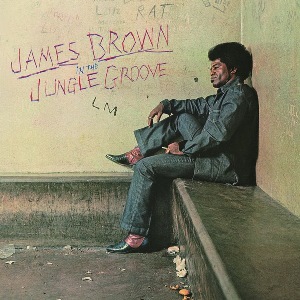The most-sampled album in history is probably James Brown’s compilation In The Jungle Groove.
It includes the original recording of “Funky Drummer Parts One And Two” along with a sampling-friendly remix. It also includes some other much-loved funk tracks. None of them have been sampled as heavily as “Funky Drummer”, but there are some contenders.
The compilation is named for a breakdown section that appears in “Give It Up or Turnit a Loose.” James Brown quiets the band down to handclaps, footstomps and congas played by Johnny Griggs. After he raps a little, James Brown cues drummer Clyde Stubblefield back in, followed by bassist Bootsy Collins and the rest of the band.
James Brown wasn’t intentionally trying to create a perfect batch of hip-hop samples in the late sixties and early seventies, but he couldn’t have succeeded any better if he had been. “Give It Up” has been sampled by everybody from Public Enemy to Everlast to Duran Duran to Miles Davis. It takes a powerful piece of music to inspire so much new work in such a variety of styles.
There’s an ugly history of racial slurs for African-Americans around jungles. James Brown made it a point to reclaim jungle imagery in a context of joyful pride. He has several songs that include a break where it’s just the congas and his chanting about being in the jungle, brother, swing on the vine, check out your mind. The history of agriculture and high tech societies is short. The stone age was long. We’ll never know exactly what music sounded like in the Stone Age, but I’d bet that James Brown’s jungle breakdowns give us a good idea.
It’s wrong of white racists to degrade black people by comparing them to monkeys because it denies the fundamental similarities that we all share with our primate cousins. As I try to imagine how our more monkey-like ancestors first started inventing music, I think it’s reasonable to assume they started with rhythm, with clapping their hands and stomping their feet. I’m convinced by Steven Mithen’s theory in The Singing Neanderthals that dance was the precursor to walking on two feet.
Rhythm is the most fundamental component of music. Every other aspect emerges from it. Pitches are very fast rhythms. If you play a series of clicks faster and faster, eventually they appear to fuse into a whir, then a thrum, then a low-pitched tone. The faster the clicks, the higher the pitch. Combining different pitches gives you melodies and harmonies.
Clapping your hands, stomping your feet and chanting are the easiest entry points to music making, and they never get old. With all of our technology, we still aren’t tired of that Stone Age sound. I’m thinking about Queen and “We Will Rock You”, about Lil Mama and “Lip Gloss”, Michael Jackson and the end of “Wanna Be Startin’ Something.”
A few years ago I went hear Questlove do a DJ set. He devoted the entire last third of it to the “clap your hands” break, looping it, processing it, chopping it up. It was mesmerizing. Swing on the vine, check out your mind!

